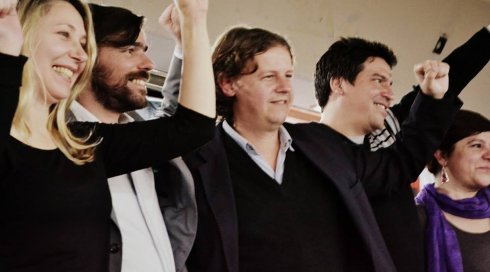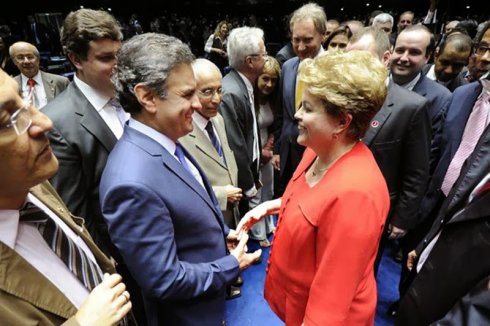United States
Historic teachers’ strike in Chicago
27/09/2012
By Celeste Murillo and Juan Andrés Gallardo
The first teachers’ strike in 25 years in the city of Chicago began on September 10. More than 25,000 female and male teachers and school personnel went out to the street and maintained the strike for 9 days, to confront the policies of Mayor Rahm Emanuel, a Democrat and, for years in the White House, the right-hand man during the administrations of Bill Clinton and Barack Obama.
This strike once again highlights the Democratic Party’s willingness to make working women and men pay the costs of the crisis, by unloading the budget deficit on them and attacking their fundamental rights. Like several states, Chicago is in the red, and the first to feel the austerity are those who work and use public services, like healthcare and education, who, in addition, are beneficiaries of public assistance programs. In a setting of unemployment and growing poverty, where more than 80% of Chicago public school students are eligible for free meals at school, Democrats and Republicans, once again, are in agreement on attacking workers. This strike, which took place as part of the mobilizations that began with the struggle to defend union rights in Wisconsin in February 2011, reached its end on Tuesday, September 18, when delegates voted to suspend the strike.
Rahm Emanuel had already announced his intention to lengthen the teachers’ workday by 90 minutes, change the system of performance evaluations and tie teachers’ jobs to students’ grades (a kind of system of rewards and punishments), and close public schools. At the same time, together with the Republican Party, the Democratic Party has been pushing educational reform at the national level, that is nothing other than covert privatization, that dismantles the public system, to transfer students to private schools subsidized by government, but financed and controlled by companies and individuals. Chicago’s public school system is one of the biggest in the country; its students are mainly African Americans and Latinos, the daughters and sons of workers and the poor. Privatization will leave thousands of children outside the school system, widening the gap that already exists with the children of white families (whose parents are professionals, with larger incomes), who attend private schools and graduate from school with greater possibilities for jobs and for gaining access to higher education. It is no accident that the strike enjoyed majority support among African Americans and Latinos, not only because their daughters and sons attend public schools, but also because in these communities the idea that workers have better working conditions when they are organized in unions also has majority support. A survey showed that 66% of parents with children in the public schools support the strike (in general, 55.5% of Chicago residents support the strike), and, among African-Americans, support is at 63%, and, among Latinos, at 65%. On the other hand, parents with children in private schools (the majority of whom, 52%, are white) are mainly against the strike. The gap between classes that exists between public and private schools is constantly growing: most children that attend public schools are African American and Latino, and they are from working-class or poor families.
The CTU teachers’ union tried to prevent the strike at all costs. The 25,000 CTU members had already shown their willingness to go out to defend their rights months ago, when the leadership held the first vote (in the US, there are multiple legal obstacles that unions have to overcome to go on strike). And they showed this willingness again on Monday, September 10, with picket lines and blockades at all the schools and the subsequent massive mobilization in the center of Chicago. The strike had broad support, despite the Democratic state government’s anti-union campaign and Obama’s complicit silence. The teachers’ union rank and file votes for the Democrats, and has supported, and is supporting Obama’s campaign; for that reason they called on him to “join the strike picket lines” (something that Obama certainly did not do; on the contrary, he backed Emanuel). Amidst the election campaign, this situation of “dissatisfaction” with Obama’s policy, by part of a group that is an historic social base for the Democratic Party, was used by Romney, the Republican candidate, who went out to attack the strike and took the opportunity to reaffirm that workers organized in unions are an obstacle to advancing in any reform, by emphasizing the “advances” that the attacks against the right to strike and collective contracts signified in Wisconsin and New Jersey (both states governed by Republicans). The tension that exists between the teachers’ bureaucracy (by pressure from their rank and file), and the Democrats, is added to the divisions provoked by the discussion of educational reform, promoted in several cities by Democratic mayors, not only in Chicago, but also in Boston, Cleveland, and Los Angeles.
In the case of Chicago, Mayor Emanuel has unleashed a campaign against the teachers since he was running for office, to destroy what they had won, blaming them for problems in the schools, deteriorated and in crisis because of the low budget. The Chicago teachers, who have a long history of militancy, know very well what the mayors and bosses’ politicians are capable of, when they find themselves threatened. One must not forget that in Chicago, the “Chicago Martyrs,” who fought for the eight-hour day in 1887, were led to the gallows, and because of them, May Day, the workers’ day, is celebrated worldwide (except in the US); ten strikers were murdered during the “Little Steel” strike, 1937, and in 1969 the civil rights activists Fred Hampton and Mark Clark, both of them Black Panther militants, were murdered in the city.
The struggle in Wisconsin as a hinge for the emergence of new phenomena
The Chicago strike is recorded in a setting of profound social crisis, provoked by the financial crisis unleashed in 2008. During these years, the workers, a minority of them unionized, the electoral basis of the Democratic Party, have seen Obama pay out million-dollar bailouts, to save banks and firms, while millions are suffering unemployment and low wages. Two facts illustrate the consequences of the crisis for the workers during these years. The first, when the “Big Three” auto companies (General Motors, Chrysler and Ford) sought a bailout plan from the government: at that time, Obama told them that, in order to get out of the crisis, it was necessary that “everyone, from the workers’ movement to the managers, creditors, and stockholders, give up something.” But the only people who “gave up” anything were the workers; the UAW (autoworkers’ union) bureaucracy accepted wage reductions, handed over rights and jeopardized the retired workers’ future (see more about the agreement in “Shameful accord of the UAW with General Motors,” http://www.ft-ci.org/spip.php?article1880?lang=es)
The other is the struggle in Wisconsin, that marked a pivotal moment in workers’ struggles in the United States. The attack on union rights, especially the right to negotiate collectively, by Republican Governor Walker, put the public-sector working women and men, teachers and young people who confronted it, on a war footing. However, the policy of the union leadership and the Democrats, of taking everything to the dead end of the legislature, made the big struggle in Wisconsin end in defeat (in which, the Republicans themselves, who won the recall election, were strengthened). Despite this, Wisconsin turned into a symbol of the defense of workers’ rights, and their example of resistance has fueled struggles and mobilizations throughout the country.
The Chicago strike is registered as part of this phenomenon, and of the first year of the mobilizations, blockades and protests, of the so-called “Occupy Wall Street” movement (OWS), whose slogan, “We are the 99%,” disputes the multi-millionaire 1% that enriched itself, while millions have been suffering poverty and unemployment. In some cities, the young people of OWS joined forces with the workers, to support them in their demands, as was the case in the shutdown of the ports in Oakland (and subsequent repression, in November 2011) and the collaboration of the young people in Seattle with the dockworkers last May 1, or the same in Chicago, with support of the struggle at Republic Windows and Doors, against the attempt to close the enterprise, where the Occupy young people showed up to put up their tents, in support of the workers.
The outcome of the strike
On Tuesday, September 18, the teachers’ union delegates had approved the suspension of the strike, although the tentative agreement proposed by the union leadership had not yet been approved. From the beginning of the strike, the union leadership made several attempts to finalize a quick agreement with Mayor Emanuel and the CPS (the agency that coordinates the schools). Finally, they achieved a “tentative agreement,” that modifies some of the plans of the local government, mainly in what refers to the work day; a different scale of wage raises is being proposed (although it will still be postponed during the next few years); the evaluation system is being modified (although it is not being eliminated, as the female and male teachers wished). Other changes related to health insurance, pensions, programs and class sizes were also introduced. The agreement must be approved by the union. The CTU in Chicago is led by a coalition called CORE, in which members of the Democratic Party and militants of the ISO (International Socialist Organization) participate. The two best-known leaders are Karen Lewis (the face in all the negotiations) and Jesse Sharkey (from the ISO).
The union bureaucracy of the CTU was always uncomfortable with the strike; it never wanted to confront the Democrats or Emanuel, despite their harsh anti-union and anti-teachers rhetoric.
Unfortunately, the ISO did not raise a single alternative to this leadership and ended up being part of the negotiations with the city, without presenting a single means of struggle to assert all the teachers’ demands, thus squandering the workers’ energy and the great solidarity with the strike. In this way, they ended up as part of the leadership that, although it is not yet being directly challenged, is indeed experiencing a healthy distrust from the rank and file that, on Sunday, September 16, repudiated the proposal from the union leadership to end the strike on Monday, before the rank and file teachers were able to read the agreement. They wanted to see the agreement with their own eyes, because they rightly distrust a leadership that has been negotiating for several months with the city government. This leadership has constantly limited the demands, accepting the restrictions that the budget deficit imposes, as if the workers were those responsible!
The CTU leadership, the ISO included, says that the result has been a big victory, without drawing up any balance sheet about the concessions made. Unlike this view, we believe that everything that has been lost was a result of a conciliatory and powerless policy against an administration that was willing to go after everything. The conquests that have been kept are the result of the willingness to fight shown by the workers, with the support of the students and families that backed the strike. For all workers in the United States, the 9 days of the strike are an enormously positive act, despite the limits imposed by the bureaucracy. Every time rights that have been won are defended, all the workers are strengthened to confront austerity measures, regardless of whether the Democrats or Republicans are in power. The worsening of the international economic crisis promises new and harsher attacks on the workers. Despite the limits that the bureaucracy imposed, the Chicago teachers’ struggle shows that the strike is the method the workers have to confront them.
September 19, 2012










